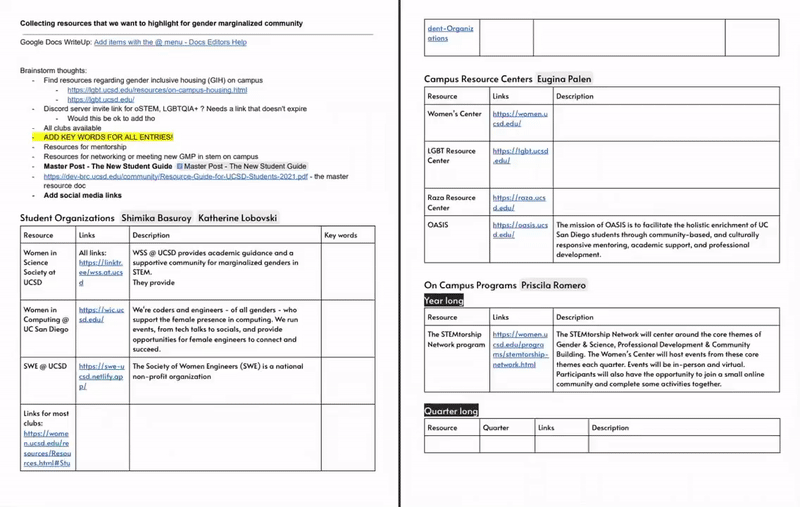Design For America
Gender Marginalized People in STEM
A community research project that addresses the lack of representation and support for gender-marginalized STEM students in UCSD.

CONTEXT
UCSD gender-marginalized students lack representation and support on campus
Who is a gender-marginalized person?
A gender-marginalized person (GMP) is someone that could identify as a transgender woman, cisgender woman, transgender man, non-binary individual, and any gender identity that has been systematically oppressed by those in power throughout history, especially in the political realm.
What is the issue?
As a group of women in STEM, we personally see the underrepresentation of our identity in our classrooms and how it affects our support system within our majors. We wanted to address this problem scope and hear the experiences of other gender marginalized students on campus in order to contribute a desirable solution to the issue.
RESEARCH
To gain further knowledge on the larger problem at hand, we looked into literary sources and statistics and found that:
Negative stereotypes around women's performance in math during their pre-college years can undermine their interest and performance in STEM fields. (Alfred & Johnson)
By the time students reach college, women are significantly underrepresented in STEM majors — for instance, only 21% of engineering majors are women and only around 19% of computer and information science majors are women. (AAUW)
Women are nearly half of the U.S workforce but only 27% of them are in the STEM industry.
Our findings motivated us to pursue our topic. After further deliberation however, we decided to broaden our scope to include people who identify as non-binary and transgender, who share similar pain points with women working in cis-men-dominated field. Hence, the umbrella term 'gender-marginalized people' was adopted in our research topic.
We then centralized our study within the UCSD community and conducted 11 in-depth user interviews to understand students' gender identity directly affect their education experience in UCSD.
INSIGHTS
Using an affinity map, we found multiple trends on student experiences as a minority in their field.

Students voiced out similar struggles with lack of connection between their peers and campus resources. Exacerbated by the ongoing pandemic, students felt alone and isolated. We broke down these key points and identified 4 issues that needs to be addressed in our solution:
Issue 1:
Resource Visibility
Resources should be easily visible and accessible to students
Issue 2:
Faculty Support
Students should be able to connect with faculty with ease
Issue 3:
Mentorship
Students should be able to find a support space to and seek mentorship
Issue 4:
Explicit Welcome
Students should feel welcome in their spaces and feel comfortable
As we further empathize with the community, my team asked ourselves:
How might we build better community support for gender-marginalized students in computing and engineering at UCSD in order to combat feelings of inadequacy and isolation?
SOLUTIONS
Resource Guide
To address the lack of resource visibility for gender-marginalized students, we worked on curating a resource guide with updated links, descriptions and contact for active groups and campus organizations.
Community Event (in-person)
To address the students' sentiment regarding alienation and the need for welcoming spaces, we hosted an in-person event in partnership with campus organizations to bring the community together.
LOGISTICS

My group and I understand that there are established programs on campus that advocate for our target demographic, so we reached out for collaboration to bring the best effort for the community.
My group is incredibly thankful to be able to work with the following organizations:




MEDIA KIT
To create a cohesive identity between our event and the resource guide, we built a media kit to promote around campus and social media.

PLAN
Due to the nature of the ongoing pandemic, lots of meetings and safety protocols were handled behind the scenes as we approach our presentation and event day.



CAPSTONE
Our capstone event successfully reached over 50 students across campus, who excitedly arrived to hear about our initiatives and the organizations that strive to help celebrate their identity and journey here in UCSD. With the help of our community partners we were able to plan activities, lead a productive discussion, and introduce the participating organizations in our resource guide. We received positive feedback from the students, who expressed hope to see more events such as ours in the future.
My group thoroughly researched multitudes of campus resource websites to create a document of resources that celebrate and highlight gender-marginalized students across UCSD. Take a look here!
Students were also able to learn more about these opportunities and programs from representatives at the event.
Community Event
We safely conducted an in-person event that presented our work to UCSD students. Organization representatives and students were able to talk about their shared experiences through discussion prompts and activities.



REFLECTION
This project gave me the opportunity to apply my skills as a UX designer outside of the digital space. Important design concepts such as the user research process — empathize, define, ideate, prototype, test — are incredibly useful in creating an all-inclusive response to a community issue. My group and I were able to grow from this project through many ways and learned useful skills that can further our journey as designers.
If I could continue this project, I would reconnect with the students we interviewed and hosted at the event to assess the impact of our project. Further insight into their issues can open an avenue into providing sustainable support for gender-marginalized students in UCSD.
